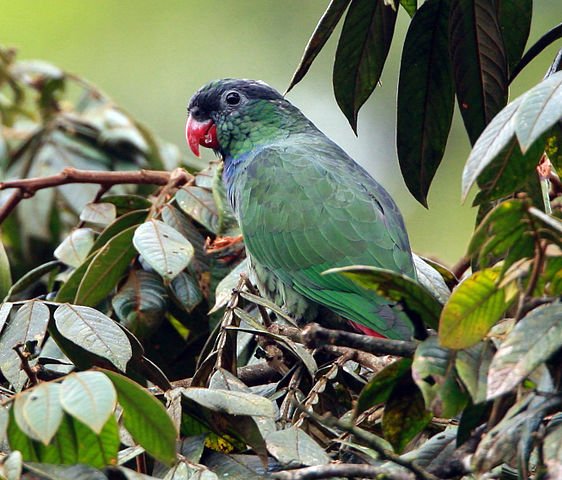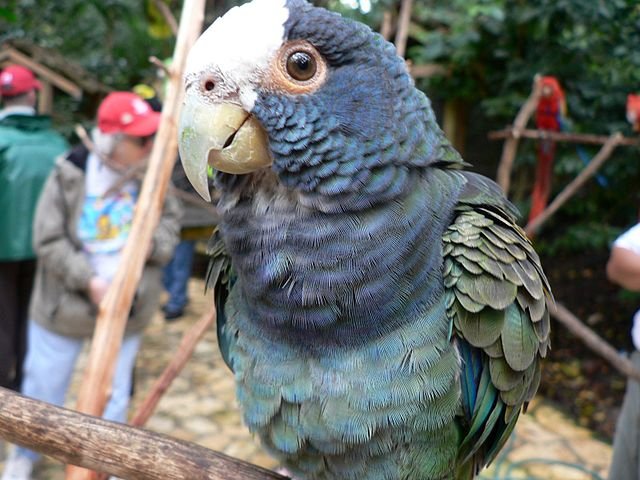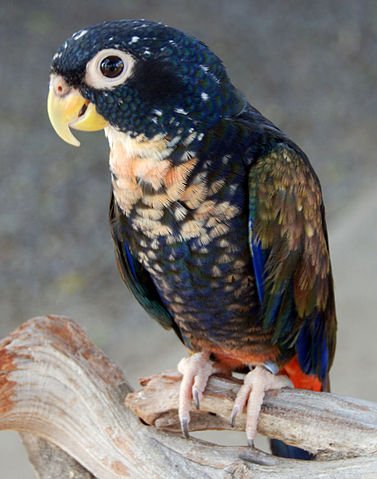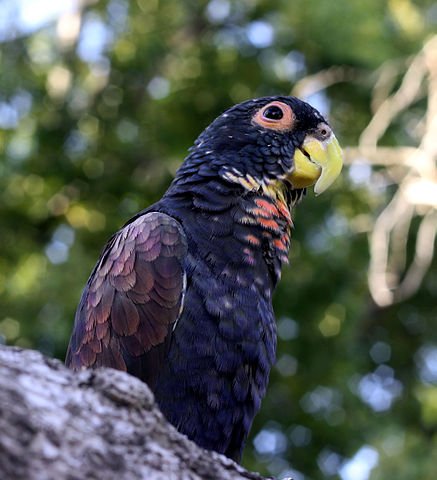Dwelling the subtropical and tropical areas of Central and South America, the Pionus family is a collective of 11 species and subspecies combined. Averse to cuddling and playing, they are still popular as a loyal companion pet courtesy their nature of forming a strong and dedicated bond with their favorite human over time. But once having bonded well, they love to be preened or scratched on head or back but only by their closest pal.
But there has been a lot of confusion surrounding this genus. Many confuse them with another popular species Amazon owing their similar appearance and behavior. But there is a huge distinction between the two. A Pionus species would always have red under-tail feathers against the green feathers of Amazon species. But that’s not all. Let’s understand all the Pionus breeds to identify them even among a bunch of Amazons or such other similar species.
Blue-headed Pionus / Pionus menstruus
One of the most commonly adopted Pionus species, Blue-headed Pionus is a medium-sized parrot measuring around 12 inches. The species has earned its name from its strikingly blue head and neck with the rest of the green plumage. The easiest way of recognizing them is a red patch on either side of the upper mandible. A slight red band on the throat can be seen. The red under-tail has blue/green tips.
Read More about Blue-Headed Pionus here:
https://parrotquaker.com/all-about-blue-headed-pionus/
A popular pet species, they have a calm temperament. Owing to their quiet nature, they have always been a popular apartment bird. Being playful, they demand the owner’s attention in moderation. A large cage filled with toys is a must for their optimum mental health. Known to be one of the rare species that rarely resort to biting, they are extremely lovable and dedicated towards their human flock.

Best known as family pets for their bonding ability with all family members alike for 35-40 years of their life. But the average Blue-headed Pionus lifespan is around 25 years only. This is due to their susceptibility to stress and other diseases like Aspergillosis. A healthy and balanced diet is the key to this species’ good health. Regular visits to the vet are a must with these Blue-headed parrots.
These birds also have two subspecies with certain variations:
Paler Blue-headed Pionus
This subspecies is very similar to the main species with a bright blue head and green plumage. But what distinguishes them from the nominate species is the overall darker texture of the plumage. The red band on the throat is more marked. Another distinct color marking is the pronounced pink colored feathers on the plumage covering their necks. The basic behavior, dietary needs, and daily care are the same as nominate species. They are slightly smaller than the nominate species at averaging around 11 inches.
Reichenow’s Blue-headed Pionus
This subspecies is also similar to the nominate species in color and markings with a few differences in tone. The blue color of the head is a deeper shade. All the green feathers have blue markings making it seem like a bluer version of the species. The bill is noticeably paler. This species is smaller than the paler blue-headed parrots and averages around 10 inches in length.
Red-billed Pionus / Pionus sordidus
Averaging around 11 inches from beak to feet, these birds aren’t much famed as pets. With around six subspecies, the Coral-billed Parrots, as they are fondly called, have a much wider range in Northern South America. As suggested by the name, their most distinctive feature is their bright red bill. The color of the head and plumage is olive green. But the feathers of the crown, cheeks, and nape have dark-blue tips. The throat and upper breast have a distinctive blue band. The under-tail coverts are customary red.

Scaly-headed parrot / Maximilian Pionus
Also known as scaly-headed Pionus, these species have recently gained fame among parrot lovers. Averaging around 11.5 inches from beak to feet, their olive-green plumage is washed with a brownish tinge. The undersides are highlighted with golden bronze shade. The dark head feathers are edged with gray strokes lending a scaly appearance and a name.
Considered as a great beginner’s parrot, they have a calm temperament and easy-to-train personality. Once taught, they are known to be obedient. They are great talkers if taught well. Their inquisitive behavior, great memory, and entertaining persona make them a great companion bird. Keep them in apartments and the neighbors wouldn’t find out a parrot next door courtesy their quiet nature.
White-crowned Pionus / Pionus senilis
This species is the smallest of all Pionus parrots. Averaging around 9.5 inches from beak to toe, they have a distinct white patch on their forehead and throat. The head, neck, belly, chest, and back has a green-blue plumage with yellowish-green patches on shoulders.

Known to be an affectionate and gentle species, they quickly get attached to a single person. A fun-loving and comical personality, they need a little attention and a lot of toys to stay entertained. They are shy and quiet birds but can still manage to learn a few words and mimic or whistle. A good diet and care make them live for 30 years and more.
Speckle-faced Pionus
Averaging around 12 inches, they have a plain green plumage on the back. The head and crown are slaty-blue with salmon-colored speckles. The nape, back of the head, and side-neck are slaty blue. The chin and cheeks are whitish as if covered with snow. The throat has a pink band. The belly is greyish brown-green with every feather having rusted tips. The bill is yellowish.
An energetic species, they are considered a little noisier than other Pionus species. But they share the usual calm and shy temperament with other species of the Pionus family.
Plum-crowned Pionus
Averaging around 11.3 inches in length, these subspecies have a similar appearance to the nominate species. With a mostly greener plumage getting paler on the underparts, the crown and nape are plum-colored. The feathers on either side of the head have a white base with purple tips. The bill is olive-yellow.
White-capped Pionus
Thought to be conspecific with the Speckle-faced Pionus previously, these species got recognized as a separate species later. The plumage is green with paler underparts. The crown and forehead are white with orange/red tips and gray inner tips. The cheeks and lores are also white with dark-gray edges. The darkish-gray ear coverts are marked pink. The throat has a pink band and turns reddish-purple as it goes down to the chest and further to brown on the belly area. The characteristic green tail with a red base assures the Pionus genus. The bill is a paler yellow. Bred rarely in captivity, these species also have a shy and calm persona.

Bronze-winged Pionus
Averaging around 11 inches, these species are famed for their unique colors and calm disposition. Having an overall purplish-blue plumage, these birds have pink and white peppered on their chins and chest. The shoulders and back feathers have striking bronze-green feathers giving them their name. The bill is yellow and they also have a customary red vent.

These birds are rarely bred and hence, difficult to find for adoption. However, they make for a great companion bird. Famed as apartment birds and best birds around children, they are affectionate and sweet with everyone around. But many of the birds from this species tend to bond excessively with a single family member and get extremely possessive of him. So much so that the bird, then, shuns all other family members. Hence, it is advised to arrange family engagements with these species to make them a family pet rather than a single-person pet.
Dusky Pionus
Averaging around 9.4 inches in length, these birds are loved by all for their unusual colors and markings. With an overall deep shade of dark-brownish color, there are distinct white feathers peppered on the upper-neck. The feathers have a pinkish-red tinge on the belly. A blue tail and red vent is an obvious proof of a Pionus genus.
Famous as a beginner parrot species, these birds are very less demanding as pets. They quickly adapt to a family setup and bond well with all the members alike. Being playful, they need a big cage to fly around and toys to play with. Lack of activity makes them succumb to stress and depression. Offering them a balanced and nutritious diet also helps these birds live exceptionally long.
Final Words
Famed as an excellent pet among parrot lovers, the Pionus family is gentle and reserve-natured. These birds are so shy that they fear seeing strangers around them and make a characteristic wheezing sound out of discomfort. Many freeze on seeing strangers approaching their cage. Time and again, owners confuse this with a stress act and seek medical care for the bird. But these species start doing fine as they are again surrounded by just their family members. This behavior backs their loyal and homely persona that just wants love and attention from their family and closed ones.



